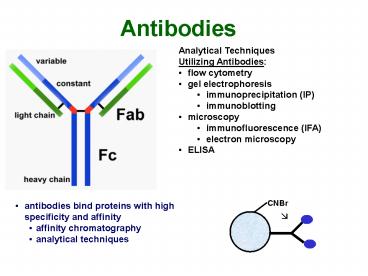Typical IP Protocol - PowerPoint PPT Presentation
1 / 10
Title:
Typical IP Protocol
Description:
2. Mix extract and Ab. 3. Add protein G-agarose, etc. 4. Extensively wash ... need no extract' control. Combined Immunoprecipitation and Immunoblotting ... – PowerPoint PPT presentation
Number of Views:65
Avg rating:3.0/5.0
Title: Typical IP Protocol
1
Antibodies
- Analytical Techniques
- Utilizing Antibodies
- flow cytometry
- gel electrophoresis
- immunoprecipitation (IP)
- immunoblotting
- microscopy
- immunofluorescence (IFA)
- electron microscopy
- ELISA
- antibodies bind proteins with high specificity
and affinity - affinity chromatography
- analytical techniques
2
Immunoprecipitation
- affinity purification based on isolation of Ag-Ab
complexes - analyze by gel electrophoresis
- initially based on centrifugation of large
supramolecular complexes - high and ?equal amounts
- isolation of Ag-Ab complexes
- fixed S. aureus
- protein A-agarose
- protein G-agarose
- Bacterial proteins that bind IgG (Fc)
- protein A (Staphylococcus aureus)
- protein G (Streptococcus)
- binds more species and subclasses
3
Typical IP Protocol
- 1. Solubilize antigen
- usually non-denaturing
- SDS excess of TX100
- 2. Mix extract and Ab
- 3. Add protein G-agarose, etc
- 4. Extensively wash
- 5. Elute with sample buffer
- 6. SDS-PAGE
- 7. Detection
- protein stain
- radioactivity
G
4
- Radiolabeling of Proteins
- carried out before IP
- metabolic (amino acids or other precursors
cells) - chemically (eg., iodination)
- IP and SDS-PAGE
- detect by autoradiography or fluorography
following electrophoresis - also provides information about synthesis,
post-translational events, etc.
5
Immunoblotting
- aka Western Blotting
- use Ab to detect protein after electrophoresis
- 1. Protein electrophoresis
- 2. Transfer proteins to membrane
- 3. Incubate membrane with antibody
- 4. Extensive washing
- 5. Detect bound antibody
- - radioactive 2nd Ab or protein A
- - ELISA
6
Enzyme-Linked ImmunoSorbent Assay
7
Detection by Chemiluminescence
8
Western Blot vs Immunoprecipitation
- Experimental Design
- eg., synthesis (IP)
- Ag concentration
- IP better for low abundance proteins
- Ag solubility
- Western for insoluble proteins
- Ab recognition
- conformational dependent epitopes
- 4o structure
9
Combined Immunoprecipitation and Immunoblotting
- carry out IP and electrophoresis
- transfer to membrane
- use same or different Ab against Ag in blotting
- need no extract control
10
Immunoassay Uses
- antigen detection, characterization,
(quantification?) - antibody detection, characterization,
(quantification?)































